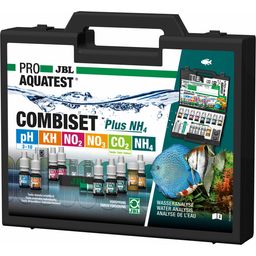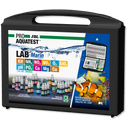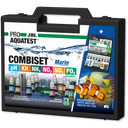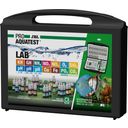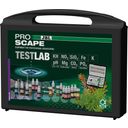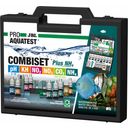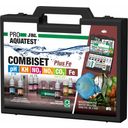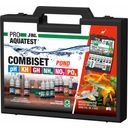JBL ProAquaTest Combi Set Plus NH4
Water tester
£50.00
(£95.42 / kg, Price shown includes 20% VAT.
Features & Advantages
- Simple and safe control of the water values in aquariums
- Determines pH value, carbonate hardness, ammonium/ammonia, nitrite, nitrate and CO2
- Add reagents to water sample, compare with colour chart
- Natural water colouring is taken into account by the comparator system
- CO2 content is determined from the pH value and KH value in the table
- Childproof reagent bottles, waterproof plastic case
Looking for spare parts for this product?
Item no.: JBL-2409000, EAN: 4014162240903
Description
The JBL ProAqua Test Combi Set Plus NH4 is a water test case with water tests for the analysis of tap water and fresh water in aquariums.
Water is not simply water. Rainwater already absorbs pollutants and once it seeps into the groundwater, it is enriched with other substances that are not all suitable for the aquarium. Constant monitoring of the water values in the aquarium, especially when setting up a new one, is the top priority for successful aquarists. With the ProAqua Test Combi Set Plus NH4, JBL enables you to quickly and precisely determine the most important water values yourself in the home laboratory. Thanks to the enclosed, very detailed instructions for use with tips and advice, water testing is child's play. The contents of delivery include all required materials such as test reagents, dosing syringes, cuvettes, measuring spoons and colour cards. The test reagents can be purchased separately.
The following tests are included in the extensive water test case JBL ProAqua Test Combi Set Plus NH4:
JBL ProAqua Test KH
Depending on the origin, water, e.g. due to the nature of the substrate, contain different amounts of different mineral salts. A large part of the dissolved salts are alkaline earth and alkali hydrogen carbonates. Together with carbonates and carbon dioxide (CO2), hydrogen carbonates form an important buffer system that prevents dangerously high pH fluctuations in water. The measured carbonate hardness (KH) provides the total concentration of hydrogen carbonate in the water and can therefore in rare cases (if mainly alkali hydrogen carbonates are present, e.g. in East African lakes) be higher than the total hardness, which only takes account of alkaline earth salts. Most freshwater fish and plants in the aquarium can be successfully maintained with a carbonate hardness of around 5-16 ° dH. For optimal CO2 fertilisation, however, the carbonate hardness should not be below 5 ° dH. If there is a lack of CO2, aquatic plants or, above all, algae consume hydrogen carbonate (biogenic decalcification) due to their rapid assimilation during photosynthesis and can thus dangerously raise the pH value for fish (over 10).
JBL ProAqua Test pH 3-10
Maintaining a suitable pH value as constant as possible is an important prerequisite for the well-being of all aquatic organisms. Above all, sudden fluctuations should be avoided. In addition, many substances dissolved in water are subject to changes depending on the pH. For example, the amount of CO2 that can be dissolved in water is directly related to the pH value. The pH value can, therefore, serve as a simple control variable for setting CO2 fertiliser systems, as long as there are no other acids (e.g. humic acids) in the water that influence the pH value. The optimal CO2 concentration for plants and harmless for fish is achieved at a pH of around 6.8-7.3. The carbonate hardness should not be below 4 ° dH. An exact pH measurement also for special applications such as fish farming, may be required. JBL PRO AQUATEST pH 6.0-7.6 is also used here. The optimum pH value for keeping most freshwater fish and plants is in the neutral range around 7. However, there are also freshwater fish that need slightly acidic or alkaline water. For particularly precise measurements of the pH value, there is the JBL PRO AQUATEST pH 6.0-7.6 (also for checking the CO2 fertilisation) for freshwater aquariums and the JBL PRO AQUATEST pH 7.4 for freshwater aquariums -9.0. For sea water organisms, pH values around 8.2 can be regarded as optimal. Especially in saltwater aquariums with lower animals (invertebrates), the consumption of calcium bicarbonate can cause the pH value (and the carbonate hardness) to drop if a supply is not made regularly. When caring for fish from slightly alkaline fresh water, such as for example, Lake Malawi and Lake Tanganyika, values around 8-8.5 are recommended. For Koi and others, pH values between 7.5-8.5 can be regarded as optimal. In the garden pond, but especially in the aquarium, if there is a lack of CO2, especially algae, due to their rapid assimilation during photosynthesis, can consume the hydrogen carbonate in the water (biogenic decalcification) and thus drive the pH value to dangerous levels for fish (over 10).
JBL PRO AQUATEST NH4
The degradation of all organic substances (feed and plant residues, fish excretions) in the aquarium and pond takes place via the so-called nitrogen cycle. Proteins in ammonium are transformed into nitrite and harmless nitrate. Certain bacteria are responsible for this process. By measuring the individual intermediate stages ammonium, nitrite and nitrate, statements can be made about the "functioning" of the system. For example, medicines to cure fish diseases can damage the beneficial cleaning bacteria and thus lead to an increase in the ammonium and / or nitrite content. As a rule, ammonium will not be measurable in a well-maintained aquarium with a powerful biological filter. Ammonium is a plant nutrient and is non-toxic to fish in low concentrations. Depending on the pH, however, ammonium can produce toxic ammonia (NH3). For this reason, a pH measurement should always be carried out with the ammonium measurement.
JBL PRO AQUATEST NO2
Like ammonia, nitrite is a strong fish poison. Depending on the sensitivity of the fish species, concentrations between 0.5 and 1 mg / l (ppm) can be fatal. Seawater fish and young fish are more sensitive than adults.
JBL PRO AQUATEST NO3
Ammonium and nitrite should not normally accumulate, but if they do, there may be a disturbance in the bacterial balance. A continuously increasing nitrate content with a low to undetectable ammonium and nitrite content shows a well-functioning bacterial balance, but at the same time indicates an insufficient balance between fish (nitrogen source) and plants (consumers). Excessive nitrate levels promote undesirable algae growth if, in addition to nitrite, phosphate is also available in the water. The nitrate content should therefore not exceed 30 mg / l in fresh water and 20 mg / l in sea water. The opposite can happen in heavily planted aquariums with just a few small fish: nitrate becomes a deficiency factor and must be replenished in order for the plants to thrive optimally.
Our expert Oliver Knott recommends:
In order to ensure that everything runs smoothly in the aquarium, the JBL ProAquaTest Combi Set Plus NH4 should be just as important as the treat tin. Thanks to the additional ammonium test, poisons can be quickly identified.
| Brands (Manufacturers): | JBL |
|---|---|
| Usage: | Aquarium, Saltwater, Fresh water |
| Usage of Measuring Devices & Water Tests: | Ammonia, Carbonate hardness, Nitrate, Nitrite, pH value |
| Manufacturer: | JBL GmbH & Co. KG, Dieselstrasse 3, 67414, Neuhofen, Germany, www.JBL.de |
Hazard and precautionary statements
Signal word: Danger
Precautionary statements:
- P101 - If medical advice is needed, have product container or label at hand.
- P102 - Keep out of reach of children.
- P303+P361+P353 - IF ON SKIN (or hair): Take off immediately all contaminated clothing. Rinse skin with water [or shower].
- P305+P351+P338 - IF IN EYES: Rinse cautiously with water for several minutes. Remove contact lenses, if present and easy to do. Continue rinsing.
- P501 - Dispose of contents/container according to local/national regulations.
Hazard statements:
- H226 - Flammable liquid and vapour
- H314 - Causes severe skin burns and eye damage.
Signal word: Warning
Precautionary statements:
- P101 - If medical advice is needed, have product container or label at hand.
- P102 - Keep out of reach of children.
- P303+P361+P353 - IF ON SKIN (or hair): Take off immediately all contaminated clothing. Rinse skin with water [or shower].
- P305+P351+P338 - IF IN EYES: Rinse cautiously with water for several minutes. Remove contact lenses, if present and easy to do. Continue rinsing.
- P501 - Dispose of contents/container according to local/national regulations.
Hazard statements:
- H226 - Flammable liquid and vapour
- H319 - Causes serious eye irritation
Signal word: Danger
Precautionary statements:
- P101 - If medical advice is needed, have product container or label at hand.
- P102 - Keep out of reach of children.
- P303+P361+P353 - IF ON SKIN (or hair): Take off immediately all contaminated clothing. Rinse skin with water [or shower].
- P305+P351+P338 - IF IN EYES: Rinse cautiously with water for several minutes. Remove contact lenses, if present and easy to do. Continue rinsing.
- P501 - Dispose of contents/container according to local/national regulations.
Hazard statements:
- H315 - Causes skin irritation
- H319 - Causes serious eye irritation
- H336 - May cause drowsiness or dizziness
- H225 - Highly flammable liquid and vapour
Signal word: Warning
Precautionary statements:
- P101 - If medical advice is needed, have product container or label at hand.
- P102 - Keep out of reach of children.
- P303+P361+P353 - IF ON SKIN (or hair): Take off immediately all contaminated clothing. Rinse skin with water [or shower].
- P305+P351+P338 - IF IN EYES: Rinse cautiously with water for several minutes. Remove contact lenses, if present and easy to do. Continue rinsing.
- P501 - Dispose of contents/container according to local/national regulations.
Hazard statements:
- H226 - Flammable liquid and vapour
- H319 - Causes serious eye irritation
Signal word: Danger
Precautionary statements:
- P101 - If medical advice is needed, have product container or label at hand.
- P102 - Keep out of reach of children.
- P303+P361+P353 - IF ON SKIN (or hair): Take off immediately all contaminated clothing. Rinse skin with water [or shower].
- P305+P351+P338 - IF IN EYES: Rinse cautiously with water for several minutes. Remove contact lenses, if present and easy to do. Continue rinsing.
- P501 - Dispose of contents/container according to local/national regulations.
Hazard statements:
- H314 - Causes severe skin burns and eye damage.
- H317 - May cause an allergic skin reaction
- H411 - Toxic to aquatic life with long lasting effects
Signal word: Danger
Precautionary statements:
- P101 - If medical advice is needed, have product container or label at hand.
- P102 - Keep out of reach of children.
- P303+P361+P353 - IF ON SKIN (or hair): Take off immediately all contaminated clothing. Rinse skin with water [or shower].
- P305+P351+P338 - IF IN EYES: Rinse cautiously with water for several minutes. Remove contact lenses, if present and easy to do. Continue rinsing.
- P501 - Dispose of contents/container according to local/national regulations.
Hazard statements:
- H314 - Causes severe skin burns and eye damage.
- H317 - May cause an allergic skin reaction
- H412 - Harmful to aquatic life with long lasting effects
- Suspected of causing genetic defects.
Related products
Similar products
Customer Reviews
0 English reviews written for JBL ProAquaTest Combi Set Plus NH4
3 customer reviews in all languages
| 5 stars | | 11 | (84%) |
|---|---|---|---|
| 4 stars | | 2 | (15%) |
| 3 stars | | 0 | (0%) |
| 2 stars | | 0 | (0%) |
| 1 Stars | | 0 | (0%) |
13 reviews
We do not have any reviews in English yet, but we do have 3 reviews available in other languages.
- No reviews available
Magazine Articles:
Discover Olibetta:
-
Great Britain: Free standard delivery from £69.90
-
Free
returns -
We operate in a
climate-conscious manner. Secure payments
with SSL encryption technology
